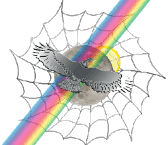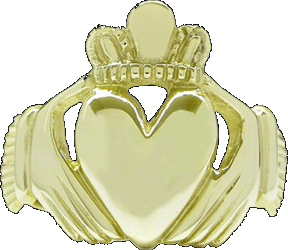

 |
 |
| |
||
 |
||
 |
||
| ‘The Claddagh Ring’ is a symbol of Love, Friendship and Loyalty. It is said to be bad luck to buy a Claddagh Ring for yourself, you must be given one as a gift. |
||
 |
||
| The original Claddagh ring is generally attributed
to Richard Joyce (or Joyes), who departed from Claddagh, on a ship enroute
to the plantations of the West Indies.
Joyce was to be married, but his ship was captured by Mediterranean pirates and the crew were sold as a slaves. Richard Joyce was sold to a Moorish goldsmith who trained Joyce in his craft. Richard Joyce soon became a master in his trade, and hand crafted a ring for the woman at home he could not forget. In 1689 Joyce was released after William III came to the throne of England and concluded an agreement whereby all his subjects who where held in captivity by the Moors were to be allowed return to their homes. The Moorish goldsmith offered Joyce his only daughter in marriage and half his wealth if he would remain in Algiers. Joyce declined and returned to Claddagh to find that the woman of his heart had never married. Joyce gave her the ring and they were married. Joyce set up a goldsmith shop in the town of Claddagh. The earliest Claddagh rings to be traced bear his mark and the initial letters of his name, RI (Richard Joyce). Later, a number of Galway goldsmiths and jewellers of Galway made Claddagh rings. The early manufacture of Claddagh rings was by cuttle-bone mould casting, then the 'cire perdue' or lost wax process up to the 1840s, when manufacture of Claddagh rings became commercialised. |
||
 |
||
The Claddagh Ring belongs to the tradition widespread group of finger rings called Fede or 'Faith rings' which date from Roman times. They are distinguished by having the bezel cut or cast in the form of two clasped hands, symbolising faith, and trust. Fede rings were popular in the Middle Ages throughout Europe. The Claddagh ring has a design of a heart being encircled by a pair of delicate hands with a crown above the heart. The hands signify friendship, the crown loyalty, and the heart love. The Claddagh ring became fashionable exchange with friends or lovers. Worn on the right hand, crown turned inward indicates that the wearer's heart is yet unoccupied, worn with the crown turned outwards reveals that love is being considered. Worn on the left hand the crown turned outward signifies that the wearer's heart is spoken for. A large number of Claddagh rings consigned to the melting pot following the Great Famine 1846/7 as there was nobody to redeem or purchase them, which contributed to the difficulty in ascertaining the origin of The Claddagh ring. The Claddagh rings that survived 'the melting pot', were kept as heirlooms with great pride and passed from mother to daughter. Today, the ring is worn extensively, with the heart turned outwards showing that the wearer is available or with the heart turned inwards to denote that the wearer is attached, and unavailable. |
||
 |
||
 |
||
|